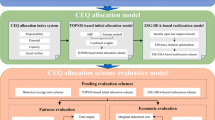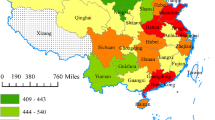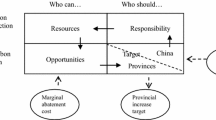Abstract
Carbon emission allocation in China is one of the most important research fields in recent years. The existing carbon allocation approaches are primary based on efficiency maximized principle or efficiency invariance principle. Such two principles, however, are both extreme cases which are particularly difficult to realize in reality. In this study, we proposed an alternative approach based on gradually efficiency improvement planning and emission reduction planning principles. Based on them, the efficiency is planning to be steadily improved after allocating carbon emission year by year rather than achieve the maximized target (efficient) in a single step or maintain the original efficiency without any improvement. Meanwhile, the total carbon emission is also planning to be reduced by a certain percent according to the promise by China in Copenhagen climate conference. Finally, the proposed method is applied to allocate the carbon emission quotas among provinces in China, and some realistic conclusions are obtained to guide in reality.

Similar content being viewed by others
Notes
Copenhagen Climate Conference means the United Nations Climate Change Conference hold in Copenhagen in December 2009, which is also the 15th Session of the Conference of Parties to the United Nation Framework Convention on Climate Change (UNFCCC) and the 5th Session of the Conference of Parties to the Kyoto Protocol.
Here, we choose the data in 2011 since it is the most recent data that we obtained.
References
An, Q., Wen, Y., Xiong, B., Yang, M., & Chen, X. (2017a). Allocation of carbon dioxide emission permits with the minimum cost for Chinese provinces. Journal of Cleaner Production, 142(2), 886–893.
An, Q., Chen, H., Xiong, B., Wu, J., & Liang, L. (2017b). Target intermediate products setting in a two-stage system with fairness concern. Omega, 73, 49–59.
Beasley, J. E. (2003). Allocating fixed costs and resources via data envelopment analysis. European Journal of Operational Research, 147(1), 198–216.
Bi, G. B., Ding, J. J., Luo, Y., & Liang, L. (2011). Resource allocation and target setting for parallel production system based on DEA. Applied Mathematical Modelling, 35(9), 4270–4280.
Charnes, A., Cooper, W. W., & Rhodes, E. (1978). Measuring the efficiency of decision making units. European Journal of Operational Research, 2(78), 429–444.
Chen, Z., Wang, J. N., Ma, G. X., & Zhang, Y. S. (2013). China tackles the health effects of air pollution. The Lancet, 382, 14–20.
Cook, W. D., & Kress, M. (1999). Characterizing an equitable allocation of shared costs: A DEA approach. European Journal of Operational Research, 119(3), 652–661.
Cook, W. D., & Zhu, J. (2005). Allocation of shared costs among decision making units: A DEA approach. Computers & Operations Research, 32(8), 2171–2178.
Ding, T., Chen, Y., Wu, H. Q., & Wei, Y. Q. (2017). Centralized fixed cost and resource allocation considering technology heterogeneity: A DEA approach. Annals of Operations Research. doi:10.1007/s10479-017-2414-6.
Feng, C. P., Chu, F., Ding, J. J., Bi, G. B., & Liang, L. (2014). Carbon Emissions Abatement (CEA) allocation and compensation schemes based on DEA. Omega, 53, 78–89.
Guo, R., Cao, X. J., Yang, X. Y., Li, Y. K., Jiang, D. H., & Li, F. T. (2010). The strategy of energy-related carbon emission reduction in Shanghai. Energy Policy, 38(1), 633–638.
Guo, L. L., Wu, C. Y., Qu, Y., & Yu, J. T. (2015). Evaluation of the energy-saving and emission-reduction potential for Chinese provinces based on regional difference coefficients. Journal of Renewable & Sustainable Energy, 7(4), 2165–2178.
Karabati, S., & Yu, G. (2001). A min-max-sum resource allocation problem and its application. Operations Research, 49(6), 913–922.
Levine, M. D., & Aden, N. T. (2008). Global carbon emissions in the coming decades: The case of China. Annual Review of Environment and Resources, 33, 1–39.
Li, Y. J., Yang, F., Liang, L., & Hua, Z. S. (2009). Allocating the fixed cost as a complement of other cost inputs: A DEA approach. European Journal of Operational Research, 197(1), 389–401.
Li, Y. J., Yang, M., Chen, Y., Dai, Q. Z., & Liang, L. (2013). Allocating a fixed cost based on data envelopment analysis and satisfaction degree. Omega, 41(1), 55–60.
Lozano, S., & Villa, G. (2004). Centralized resource allocation using data envelopment analysis. Journal of Productivity Analysis, 22, 143–161.
Pan, X. Z., Teng, F., & Wang, G. H. (2014). Sharing emission space at an equitable basis: Allocation scheme based on the equal cumulative emission per capita principle. Applied Energy, 113, 1810–1818.
Ringius, L., Torvanger, A., & Holtsmark, B. (1998). Can multi-criteria rules fairly distribute climate burdens? OECD results from three burden sharing rules. Energy Policy, 26(10), 777–793.
Wang, K., Zhang, X., Wei, Y. M., & Yu, S. W. (2013). Regional allocation of CO\(_2\) emissions allowance over provinces in China by 2020. Energy Policy, 54, 214–229.
Wei, C., Ni, J. L., & Du, L. M. (2012). Regional allocation of carbon dioxide abatement in China. China Economic Review, 23(3), 552–565.
Wu, H., Du, S., Liang, L., & Zhou, Y. (2013). A DEA-based approach for fair reduction and reallocation of emission permits. Mathematical & Computer Modelling, 58(5–6), 1095–1101.
Wu, H., Zhang, D., Chen, B., & Yang, M. (2017). Allocation of emission permits based on DEA and production stability. Infor Information Systems & Operational Research. doi:10.1080/03155986.2017.1327629.
Yu, S. W., Wei, Y. M., Fan, J. L., Zhang, X., & Wang, K. (2012). Exploring the regional characteristics of interprovincial CO\(_2\) emissions in China: An improved fuzzy clustering analysis based on particle swarm optimization. Applied Energy, 42, 521–529.
Zeng, S., Xu, Y., Wang, L., Chen, J. Y., & Li, Q. R. (2016). Forecasting the allocative efficiency of carbon emission allowance financial assets in China at the provincial level in 2020. Energies, 9(329), 1–18.
Zhang, Y. J., & Da, Y. B. (2013). Decomposing the changes of energy-related carbon emissions in China: Evidence from the PDA approach. Nature Hazards, 69, 1109–1122.
Zhang, Y. J., Wang, A. D., & Da, Y. B. (2014). Regional allocation of carbon emission quotas in China: Evidence from the Shapley value method. Energy Policy, 74, 454–464.
Zhou, P., Zhang, L., Zhou, D. Q., & Xia, W. J. (2013). Modeling economic performance of interprovincial CO\(_2\) emission reduction quota trading in China. Applied Energy, 112, 1518–1528.
Zofío, J. L., & Prieto, A. M. (2001). Environmental efficiency and regulatory standards: The case of CO\(_2\) emissions form OECD industries. Resource and Energy Economics, 23(1), 63–83.
Acknowledgements
This research was supported by National Natural Science Foundation of China (Grants Nos. 71601067, 71501189, 71471053, 71601062), Natural Science Foundation of Hunan Province (2017JJ3397), the open project of “Mobile Health” Ministry of Education-China Mobile Joint Laboratory of Central South University, the national Key R&D Program of China (No. 2016YFC0803203), Anhui Provincial Natural Science Foundation (No. 1708085MG176) and the Postdoctoral Foundation of China (No. 2017M612071).
Author information
Authors and Affiliations
Corresponding author
Appendices
Appendix A: The proof of Theorem 1
Theorem 1
To each DMU\(_{d}\), the efficiency based on the gradually efficiency improvement principle (\(\rho _d -\rho _d e_d^*+e_d^*\)) is a lower bound of CCR efficiency after carbon emission allocated (\(e_{d}^{allo\_CCR} \)), that is, \(\rho _d -\rho _d e_d^*+e_d^*\le e_{d}^{allo\_CCR}\).
Proof
According to the Theorem 1, the CCR efficiency \(e_{d}^{allo\_CCR} \) with the allocated carbon emission is calculated by
where \(R_{j}^{*}\) is the optimal allocated carbon emission in the model (6).
Assume \((u_{r}^*,v_{i}^*,R_{r}^*)(\forall r,i,j)\) is the optimal solution of the model (6), so it satisfies the first constraint of the model (4) as follows:
From section 3.1, we know that \(\rho _d -\rho _d e_d^*+e_d^*\le 1\). Therefore, we have
which indicates that \((u_r^*, v_i^*, R_j^*),(\forall r,i,j)\) is also the feasible solution of the model (A.1). As the objective function of the model (A.1) is the maximized function, we can obtain that
which completes the proof of the Theorem 1. \(\square \)
Appendix B: An algorithm to solve model (6)
Model (6) is a multi-objective programming, so we present an algorithm to solve model (6) to obtain a unique carbon emission allocation inspired by Li et al. (2013).
Let \(\mathop {\max }\limits _{1\le d\le n}R_d=\varphi \), then model (6) can be transformed into the following model:
Step 1 Let l=1, the optimal solution to model (7) is represented by (\(R_{1j}^*\), \(u_{1r}^*\), \(v_{1i}^*\), \(\forall j,r,i)\). If \(R_j =\varphi _1^*\), then denote the DMU set with a same allocated carbon emission \(\varphi _1^*\) as \(J_1 =\{j|R_j =\varphi _1^*,\;\forall j\in J_0 \},\) then \(R_j^*=R_{1j}^*,\;\forall j\in J_1 \) and the number of DMUs with the same allocated carbon emission \(\varphi _1^*\) is denoted by \(n_{1}\). Then the other DMUs form a set denoted as \(J_2 =\{j|R_j <\varphi _1^*,\;\forall j\in J_0 \}\).Apparently, \(J_0 =J_1 \cup J_2 ,{}\;J_0 =\{1,2,\ldots ,n\}\) holds. If \(n_1 =m+s\), then the procedure stops and the optimal solution (\(R_{1j}^*\), \(u_{1r}^*\), \(v_{1i}^*\), \(\forall j,r,i)\) is unique. The reason can be seen in Li et al. (2013). If \(n_1 <m+s\), then go to step 2.
Step 2 Let \(l=l+1\), calculate the following general model:
From model (8), the optimal (\(R_{lj}^*,u_{lr}^*,v_{li}^*,\forall j,r,i\)) are calculated. Similarly, \(J_{2l-2} \) can also be grouped into two subsets: \(J_{2l-1} =\{j|R_j =\varphi _l^*,\;\forall j\in J_{2l-2} \}\), then \(R_j^*=R_{lj}^*,\;\forall j\in J_{2l-1}, \quad J_{2l} =\{j|R_j <\varphi _l^*,\;\forall j\in J_{2l-2} \}=J_{2l-2} -J_{2l-1} \). In addition, the numbers of DMUs with the same allocated carbon emission \(\varphi _1^*\) is denoted as \(n_{l}\). If \(n_1 +n_2 +\cdots +n_l <m+s\), then run step 2 again. Until \(n_1 +n_2 +\cdots +n_l =m+s\), the procedure stops and the optimal solution (\(R_{lj}^*\), \(u_{lr}^*\), \(v_{li}^*\), \(\forall j,r,i\)) is obtained uniquely. The reason can also be seen in Li et al. (2013). As a consequence, the carbon emission allocation can be uniquely determined as (\(R_j^*=R_{lj}^*,\;\forall j\in J_0 \)).
Rights and permissions
About this article
Cite this article
Yang, M., An, Q., Ding, T. et al. Carbon emission allocation in China based on gradually efficiency improvement and emission reduction planning principle. Ann Oper Res 278, 123–139 (2019). https://doi.org/10.1007/s10479-017-2682-1
Published:
Issue Date:
DOI: https://doi.org/10.1007/s10479-017-2682-1




